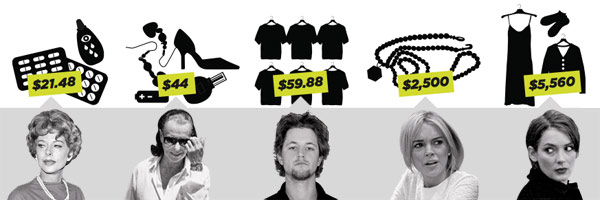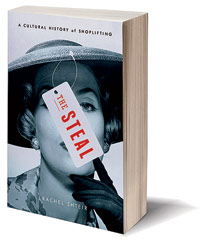
THE PRICE OF FAME: Celebrities who have been arrested for theft. From left: Hedy Lamarr, Bess Myerson, Mike Leake, Lindsay Lohan, and Winona Ryder
 A decade later, the videotapes remain just as compelling: A slight woman wanders through the floors of the Saks Fifth Avenue department store in Beverly Hills, California. She looks sloppy—an ill-fitted trench coat over a black dress—and she is encumbered with shopping bags and garment carriers. She definitely does not match the elegant surroundings. Built in 1938, this particular store has a history of catering to a privileged crowd in a wealthy neighborhood. To many of the customers, the individual designer boutiques may seem like exploding personal closets.
A decade later, the videotapes remain just as compelling: A slight woman wanders through the floors of the Saks Fifth Avenue department store in Beverly Hills, California. She looks sloppy—an ill-fitted trench coat over a black dress—and she is encumbered with shopping bags and garment carriers. She definitely does not match the elegant surroundings. Built in 1938, this particular store has a history of catering to a privileged crowd in a wealthy neighborhood. To many of the customers, the individual designer boutiques may seem like exploding personal closets.
Perhaps that’s what confused actress Winona Ryder back in 2001, causing her to shoplift $5,560 worth of items, including a Gucci dress ($1,600), an Yves Saint Laurent blouse ($755), and seven pairs of socks. Or maybe she just didn’t believe in paying retail.
“Watching the tapes, I felt that it was more exciting for her to steal the objects than to buy them,” says Rachel Shteir, an associate professor at the Theatre School at DePaul University. That exhilaration is one of the dichotomies that Shteir explores in her new book, The Steal: A Cultural History of Shoplifting (Penguin Press, $25.95). Riveted by the security tape images of Ryder aimlessly stealing hats, purses, and clothes, Shteir undertook a serious study of shoplifting. “When I saw her wandering around the store with all those glittering things, it resonated with me as a scene from American literature. It was a moment from Sister Carrie or The Great Gatsby, something that continues to speak to us.”
The 47-year-old Shteir is an expert at exploring cultural phenomena previously ignored by academia. Her earlier books are Striptease: The Untold History of the Girlie Show and Gypsy: The Art of the Tease. In her new book, Shteir crafts a detailed history of shoplifting, from its modern roots in Elizabethan England to today’s pop culture—and, indeed, much of the book’s pulse comes from the intrigue surrounding celebrities who feel compelled to lift anything from a lipstick to expensive jewelry. The range of celebs who have been caught stealing is wide: former Disney star Lindsay Lohan (who walked out of a jewelry store wearing a $2,500 necklace), ex–Bush adviser Claude Allen (who claimed that the stress of Hurricane Katrina made him take items from several Target stores, including a printer and a mop), former Miss America Bess Myerson, singer Dean Martin, 1940s actress Hedy Lamarr. And after the book went to press, Cincinnati Reds pitcher Mike Leake was arrested for the theft of six T-shirts from Macy’s (his charges were later reduced to unauthorized use of property). “We’re fascinated by the idea of someone who doesn’t need to do it, but still does it,” says Shteir.
Psychologists don’t agree on why people shoplift, and Shteir notes that the common thought about stealing can change with the times. For example, in the 1970s, shoplifting became a symbol of political resistance, thanks to Abbie Hoffman’s Steal This Book. But according to Shteir, our society is currently most comfortable thinking of shoplifting as an addiction, the same kind of risk/reward ride that comes with gambling. Interviews she conducted with active shoplifters confirm a thrill-of-the-steal sensation, as well as pride in the ability to beat “the man.” “Some view it as a game, some as an entitlement, and others are drawn to the secret excitement,” Shteir says.
Shteir believes, too, that the sexual politics surrounding shoplifting has been misleading. According to her research, statistics show that men shoplift as much as women. “But in many ways, it is viewed as a feminine activity. There was an idea in the early 20th century that women steal because of sexual frustrations. Yet anyone I interviewed totally denied this.”
Ryder’s career has yet to recover from her famed shopping trip. She never testified at her trial, but since then she has given a variety of reasons for why she did it, including researching a role and coping with stress. Says Shteir: “To me, she looks like she’s acting in those tapes. And that’s what I came to believe about all shoplifters: that they want to become something other than the way they are. Or who they are. It’s a very American story and yet a very alien one, too.”
Photography: (from left) AP Photo; Alden E. Kehler/AP Photo; Hamilton County Sheriff’s Office via The Cincinnati Enquirer/AP Photo; SIPA via AP Images; Nick Ut/AP Photo)


